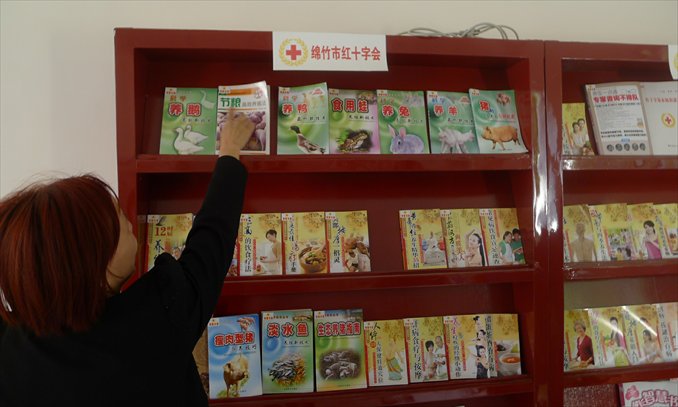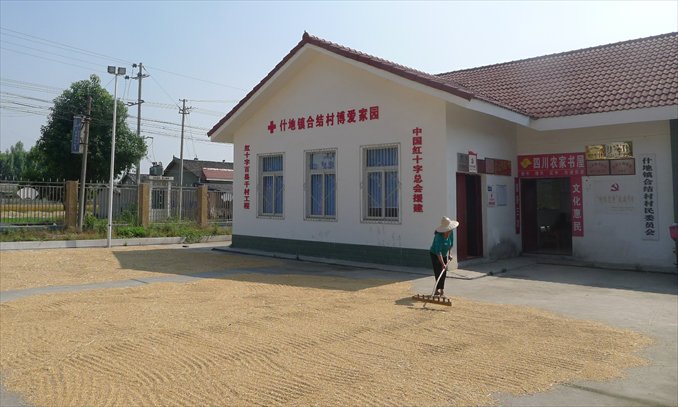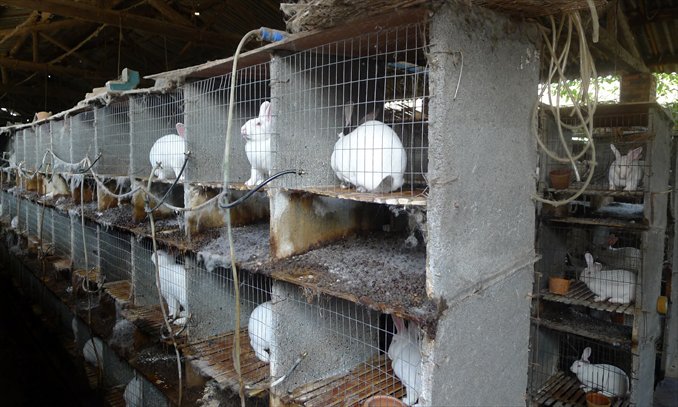A look into Red Cross Society of China’s alleged misuse of quake zone donations



While the International Federation of Red Cross and Red Crescent Societies celebrated 150 years of humanitarian work around the world on Wednesday, the Red Cross Society of China (RCSC) is facing its most serious crisis after coming to the country 109 years ago.
On April 15, one month before the fifth anniversary of the Wenchuan earthquake, senior RCSC leaders gathered in the southwestern city of Chengdu to review the outcome of an RCSC brand project conducted in disaster areas over the past two years.
The project, named Boai Community, aims to build 248 grass-roots community projects organized and operated by the RCSC within two years in six provincial regions affected by the Wenchuan earthquake to develop disaster prevention and health services for local residents.
RCSC officials praised the projects' results and Zhao Baige, standing vice-president of the RCSC, said that the RCSC will continue to invest some 100 million yuan ($16.3 million) over the next three years, according to the Xinhua News Agency.
However, just two weeks later, the project became famous throughout the country in a way none of these leaders had anticipated.
Diverted funds
On April 25, a group of artists complained online that 84 million yuan in donations raised through an art auction in 2008, which they had delivered to the RCSC and had intended to go to Qingchengshan town, Dujiangyan, Sichuan Province to build art schools and help protect Qiang ethnic culture, may have been diverted to other projects.
The artists claimed they had made several inquiries to the RCSC about the use of their donations over the past five years but never received a specific reply.
On May 1, the RCSC released a statement admitting that the funds raised by the artists had been spent on another major project - the Boai Community.
Although the RCSC apologized for not properly communicating with the donors, they insisted the money was still being used to rebuild the disaster areas, which was the donors' initial intention.
However, some donors didn't buy the explanation. "According to the law, they don't have the right to change the use of donations without donors' permission," Chen Mo, a curator based in Chengdu and the donation organizer, told the Global Times.
Chen said his friend, Zhang Xiaochuan, a painter who donated more than 20 million yuan through auctions, told him she felt disappointed and sad after she learned of how the RCSC handled their donations and said she would not consider donating to the RCSC anymore.
"What the RCSC did should never be allowed. If they can justify what they did this time, it will set a dangerous precedent that allows them to handle donations however they want," Chen said.
Hit by scandals
Unlike other Red Cross and Red Crescent Societies around the world, which are mostly independent non-governmental organizations, the RCSC is a ministry-level institution directly under the State Council. After the People's Republic of China was established in 1949, the RCSC became an affiliated unit of the Ministry of Health until 2004.
The RCSC had more than 26 million members across the country by 2011 and had done a great deal of humanitarian and disaster relief work over the past decades.
However, a series of scandals has brought confidence in the RCSC to an all-time low.
This atmosphere worsened in 2011 after the "Guo Meimei Affair", when a young woman who claimed to be a general manager of a company affiliated with the RCSC boasted of her great wealth on her verified Weibo account. She posted photographs of herself posing beside a high-priced sports car and carrying luxury handbags.
The media later dug out proof of commercial activities related to the RCSC which forced Red Cross Commerce, a body associated with the RCSC, to close at the end of 2011.
After the Boai Community incident came to light, netizens found from the RCSC's official explanation of the Boai Community project that it had accepted millions of yuan from the Red Cross Society of Singapore and Red Cross Society of Hong Kong over the past few years.
"If the donations by the artists were used on the Boai Community project, then where did the money donated for the project by other Red Cross Societies go?" one netizen asked on Tianya.com.
Facts on the ground
To find out the exact situation regarding the Boai Community projects, the Global Times conducted a field investigation into seven project locations in Sichuan. As the most seriously affected disaster area, Sichuan held the biggest number of rebuilding projects as well as relief resources.
Nianhua village in Xiaode town, Mianzhu, Sichuan Province is one of 148 Boai Community project venues in Sichuan. According to Zheng Zemin, standing vice-president of the RCSC Mianzhu Branch in Sichuan, each project is made up of three similar parts: 100,000 yuan for infrastructure construction; 80,000 yuan for sponsoring eight local residents to develop livelihoods, and the remainder goes to building up primary-level Red Cross Society organizations and carrying out training programs.
Zheng said that all construction work for the project had to go through a formal bidding and checking process and all expenses were listed in detailed financial statements that had to be submitted to higher Red Cross organizations each quarter.
And they showed all these documents to the Global Times.
"Red Cross money is used as strictly as government funds," Zheng said.
In Beichuan county, one of the places hit most severely by the Wenchuan earthquake, there are three Boai Community projects.
According to Wang Lixin, deputy director of the Beichuan Red Cross Society, their projects included establishing a satellite communication system which can secure communication even under isolated conditions as well as building several roads for farmers living in mountain areas.
Shidi village is home to another Boai Community project. Li Guihua, a local villager sponsored by the project, told the Global Times that she used the 10,000 yuan to purchase 200 leverets last September and is now raising some 3,000 rabbits.
Now each rabbit can be sold for 70 yuan on the market.
"The earthquake destroyed everything of ours. Thanks to the money the Red Cross gave us, we can start our life again and make a living by raising rabbits," she said.
According to the project plan, villagers like Li who accept the money are expected to return the 10,000 yuan to the Red Cross society one year later without interest so that it can be given to someone else who needs help.
"Those sponsored villagers were selected through discussions among the villagers themselves. They knew who really needed help and who are honest and capable of developing a livelihood and returning the money on time," Wang from the Beichuan Red Cross society said.
Strict supervision
According to an RCSC statement, the money invested in the Boai Community came from the remainder of the donations used for Wenchuan earthquake rebuilding.
After the Wenchuan earthquake, the RCSC claimed it had collected more than 19.7 billion yuan in donations, of which nearly 200 million yuan was used for the Boai Community project.
Liu Guangju, director of the Boai Community project at the RCSC Sichuan Branch, told the Global Times that Boai Community project is a beneficial supplement for Wenchuan rebuilding work, all invested money came from the RCSC and the whole project has a strict declaration and auditing system.
"The RCSC will not give us one yuan more than the project budget," Liu said, adding that so far they had received 75 percent of the money from the RCSC and had distributed it all to local Red Cross organizations.
"We realized that with hardware construction work about to be completed in the disaster area, community rebuilding has just started, and this is the purpose of the Boai Community project," Liu said.
Long Junsheng, general-secretary of the RCSC Guangxi Branch, told the Global Times that the artists' funds weren't used as originally intended because most rebuilding projects such as schools, hospitals and other public facilities are usually arranged by the government.
"These projects are all 'political projects' which would not easily go to the Red Cross Society, so the RCSC had to spend donations on its own projects like the Boai Community," he said.
"It is normal to see that donors' initial donation wishes can't be realized in practical work because the actual situation is complicated," Long said.
On the question of sponsorship funds from overseas Red Cross Societies for Boai Community projects, Yuan Bo, secretary-general of the RCSC Sichuan Branch, explained that their projects were separate from these 248 RCSC projects.
"The Red Cross Society of Hong Kong has been doing projects similar to the RCSC Boai communities as early as 2008 in cooperation with us and is planning to expand to 100 more venues in the next three years. As for Singapore, they invested 15 million yuan in 25 projects in cooperation with the RCSC," Yuan said.
"We would listen carefully to all kinds of critical opinions to improve our work," said Zhao Wanhua, standing vice-president of the RCSC Sichuan Branch.
But some experts believe the road to regaining the public's trust will be long and hard.
"Being transparent to donors and respecting their wishes is the foundation of modern public welfare philanthropy. Donor satisfaction is the highest standard for public charity," said Wang Zhenyao, dean of Beijing Normal University's China Philanthropy Research Institute.
"Reforming the system is an essential issue for the RCSC. As long as current non-transparent accounting and operating systems remain, it is difficult to expect any real change," he said.